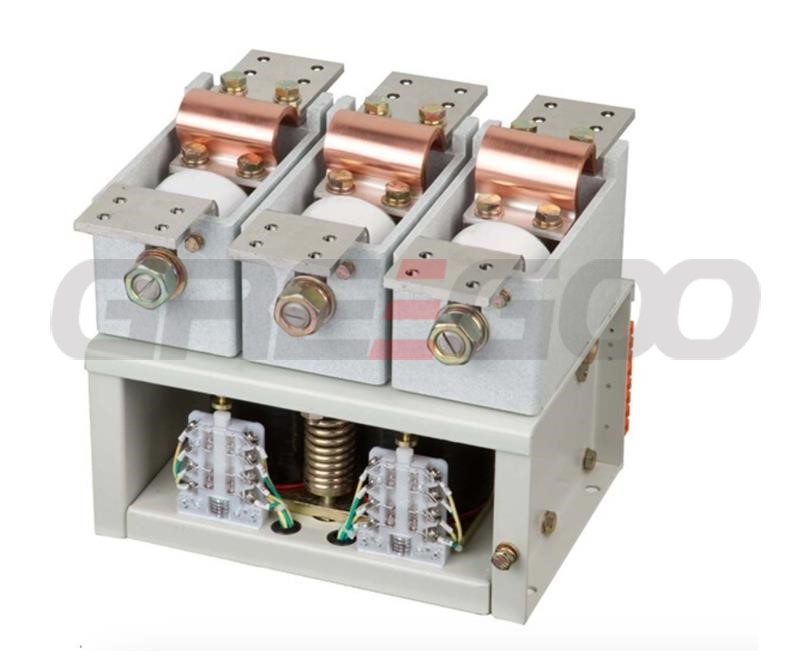Vacuum Contactor
Home Products Vacuum Contactor1140V Vacuum ContactorVacuum Contactor
Vacuum Contactor
A vacuum contactor is an electrical device with contacts enclosed in a sealed unit called a vacuum interrupter. This vacuum environment allows the contacts to perform quick and clean "make" and "break" operations, even in harsh and dirty conditions.

The working principle of a vacuum contactor is primarily based on making and breaking the current in a vacuum environment. Its core components include a vacuum interrupter, movable and stationary contacts, and an electromagnetic operating mechanism. Here is a brief explanation of its working principle:
Vacuum Interrupter: The key component of a vacuum contactor is the vacuum interrupter, which consists of a pair of movable and stationary contacts enclosed in a sealed vacuum container. In a vacuum environment, there is no air or other gaseous medium, making it difficult for an arc to sustain.
Current Making: When the contactor coil is energized, the electromagnetic operating mechanism generates a magnetic field that pushes the movable contact to connect with the stationary contact, thus closing the circuit and allowing current to flow through.
Current Breaking: To break the circuit, the contactor coil is de-energized, the electromagnetic force disappears, and a spring or other mechanical device causes the movable contact to separate from the stationary contact. In a vacuum, the arc cannot be sustained for long, so it extinguishes quickly, effectively interrupting the current.
Arc Extinguishing: At the moment the contacts separate, an arc may be generated, but due to the high insulating properties of the vacuum environment, the arc extinguishes in a very short time. This rapid arc extinguishing capability is a significant advantage of vacuum contactors.
Through this process, vacuum contactors can safely and reliably make and break circuits under high voltage and large current conditions.
When selecting a vacuum contactor, consider the following key factors to ensure it meets specific application requirements:
Rated Voltage and Current: Choose a vacuum contactor based on the operating voltage and current of the circuit. Ensure that the contactor's rated voltage and current meet or exceed the actual application requirements.
Operating Environment: Consider the working environment of the contactor, including temperature, humidity, and altitude. Some environments may require specially designed contactors, such as high altitude.
Type of Load: Select an appropriate contactor based on the nature of the load (e.g., motors, transformers, capacitors). Different types of loads may require different contactor characteristics, such as varying switching capacities and operating frequencies.
Operating Frequency: Determine the operating frequency of the contactor, i.e., the number of switching operations per hour or day. High-frequency operations may require more durable contactors.
Mechanical and Electrical Life: Choose a contactor with sufficient mechanical and electrical life to ensure reliable operation throughout the expected service period.
Control Voltage: Select a contactor coil voltage that matches the control circuit voltage.
Brand and Quality: Greegoo brand of high-quality vacuum contactor can ensure the reliability and safety in your application.
Standards and Certifications: Ensure that the selected vacuum contactor complies with relevant industry standards and certification requirements to guarantee its safety and compatibility.
By considering these factors comprehensively, you can select the most suitable vacuum contactor for specific application needs.
Electric holding and magnetic holding vacuum contactors differ in their working principles and applications:
|
Electric Holding Vacuum Contactor: Working Principle: Electric holding contactors maintain the closed state of the contactor through continuous current. When the coil is energized, the contactor Energy Consumption: Since continuous power is needed to keep the contactor closed, electric holding contactors have relatively higher energy consumption. Application Scenarios: Suitable for situations where the closed state needs to be maintained for a long time, but may not be ideal for applications with high energy-saving requirements. |
Magnetic Holding Vacuum Contactor: Working Principle: Magnetic holding contactors use permanent magnet to maintain the closed state of the contactor. The coil is energized briefly only when switching states, and then the state is maintained by magnetic force. Energy Consumption: Since energy is only consumed during switching, magnetic holding contactors are more energy-efficient. Application Scenarios: Suitable for applications requiring frequent switching and strict energy consumption requirements, such as battery-powered systems or devices that need to maintain state for extended periods. |
In summary, the choice between these types of vacuum contactors depends on specific application needs, including energy consumption, operation frequency, and system design.
Need more information?
Contact us to request pricing, availability and customization options.

2000A 2600A 3200A Vacuum Contactor
GVC611-2000A/1.5KV, GVC611-2600A/1.5KV, GVC611-3200A/1.5KV
View More
GVC7-1600A 3 pole vacuum contactors
GVC7-1600A/1140V
View More
CKJ50 1000A, 1250A Vacuum Contactors
CKJ50-1000A/1140V, CKJ50-1250A/1140V
View More
GVC3-800/1000/1250A 3 pole vacuum contactors
GVC3-800A/1140V, GVC3-1000A/1140V, GVC3-1250A/1140V
View More

















